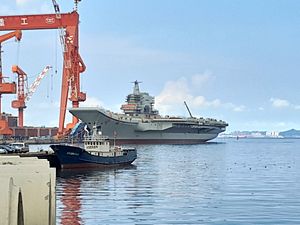China’s first indigenously built aircraft carrier, the Type 001A, is running into a few problems during sea trials, the South China Morning Post reports, citing military observers. The vessel, which is the largest warship to be built in China, is a 65,000-ton aircraft carrier—the successor to the Liaoning, which was a refurbished Soviet-era carrier.
The Type 001A’s sea trials are taking place off Dalian, where the vessel was constructed. A “no-sail zone” announcement issued by the Liaoning Maritime Safety Administration demarcated an area for this week’s trial. The area encompasses some 3,400 sq km.
The fact that the Type 001A may need to undergo additional sea trials is not necessarily unusual or an indicator that the vessel might be delayed. Part of what PLA Navy crews and technicians are studying during these trials is just how well the vessel performs.
In addition to the carrier’s ability to move on the seas, the trials have reportedly started to test its ability to recover and launch aircraft. At least one Shenyang J-15, China’s fourth-generation carrier-based fighter, was seen on board the vessel.
The Type 001A entered sea trials in April this year, as The Diplomat reported. The vessel has not yet sailed far from Dalian Shipbuilding Industry Company (DSIC) shipyard in the port of Dalian in China’s Liaoning province.
The carrier, which remains unnamed, resembles a larger version of the Liaoning in capability. Notably, it does not feature advanced features like nuclear propulsion, or the Catapult-Assisted Take-Off But Arrested Recovery (CATOBAR) systems used on U.S. Navy carriers.
The Type 001A features a ski-jump assisted Short Take-Off But Arrested Recovery (STOBAR) launch system. These systems are less flexible than their CATOBAR counterparts and can stress the airframes of carrier-based aircraft quicker.
A third Chinese carrier — the second indigenous one overall — is being built in China. That carrier may feature an electromagnetic launch systems for its airwing. The Type 002, as this third carrier is called, is being built at Jiangnan Shipyard.
It is expected to be considerably larger than both the Liaoning and the Type 001A at some 80,000 tons. While it will feature a CATOBAR launch system for aircraft, it will still rely on conventional propulsion, limiting its range and endurance.
China may operate a total carrier fleet of six. The Liaoning, while in operation now for more than two years, has been primarily used as a training platform for People’s Liberation Army Navy sailors and airmen to gain experience in carrier-based operations.

































